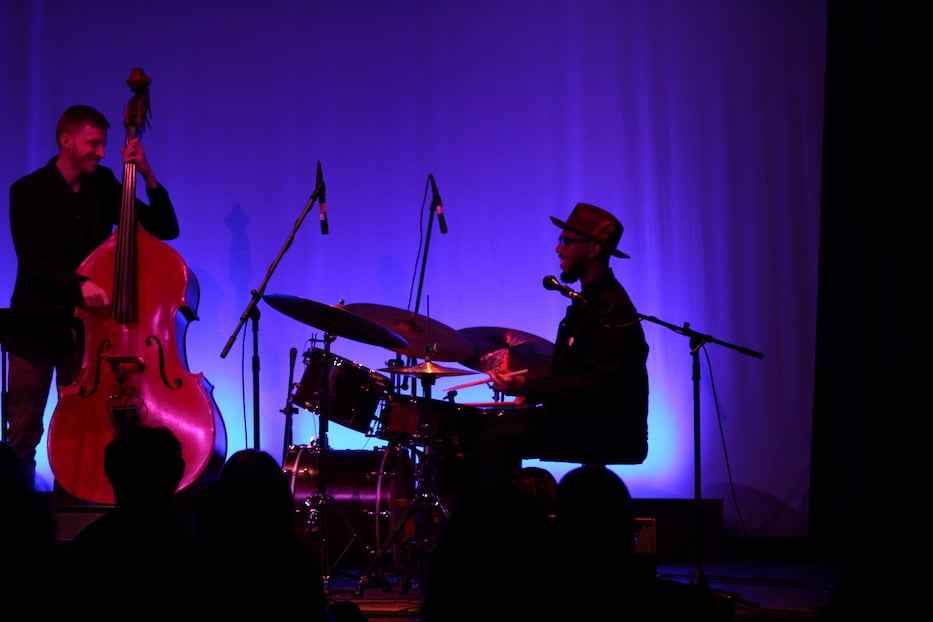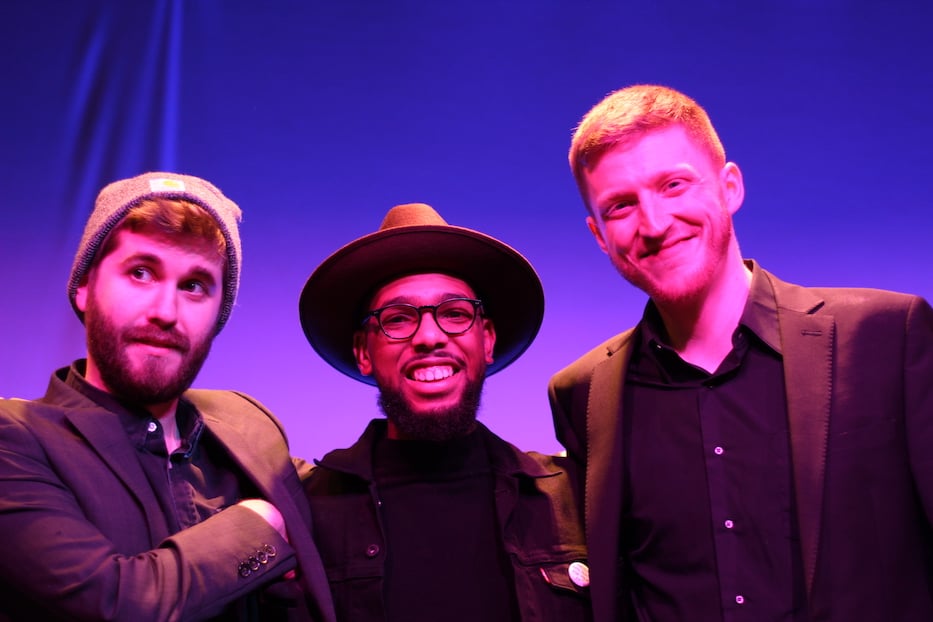
Amelia Stefanovics Photos.
Thrumming, deep bass notes built under the guitar and drums, bounding forward with each note. As the sound crested, it felt as if it was trying to grab for something just out of reach. The drums switched up the beat, growing in intensity. When the song finished, the crowd roared its appreciation.
Ryan Sands had a tiger by the tail—sonically, at least—and he wasn’t going to let it go.
That was the sound at the Milford Arts Council (the MAC) last Friday, as the Ryan Sands Trio performed to an audience of roughly 50 people. It was part of the MAC’s ongoing jazz series, where performers Jeff Fuller & Friends will return on April 6.
The MAC, it was clear Friday, is a welcoming home for jazz. The high ceiling and gentle arc of the walls provide enough acoustics for it to be a concert venue. Bedecked with local visual art, it transformed into a fitting stage for the guitar, bass, and drum jazz trio. With Sands on the drums, Max Lighton the guitar, and Kris Monson on the bass, the group seemed unstoppable.
“The moment I am most happy in is when I am playing,” Sands said in an interview Friday. “I love the freedom of jazz. It’s an expressive genre, and I experiment a lot with it. After every performance, I always look forward to the next one.”
The trio’s first piece, appropriately titled “The Windup” started the show in a dizzying shower of jazz. Like a windup toy, the music started quite slowly, and then sped up as its volume rose. The complex rhythm of the drums matched the melody of the electric guitar, coupled with the deep tones of the bass. It made it nearly impossible not to tap a foot—or two—along to the rhythm.
The trio was just getting started. Many of their songs played with the idea of classical jazz, country, meditative music, and other genres. Some were new re-workings of old classics, like Rodgers & Hammerstein's slow “People Will Say We Are in Love” and Stevie Wonder’s ‘I Just Called To Say I Love You.” Others were compositions by the musicians themselves.

Amelia Stefanovics Photos.
One composition by Monson was named “You Can Lead A Horse To Water.” It was inspired by the phrase “You can lead a horse to water, but you cannot make it drink.” Written during the thick of the pandemic, it was a very hectic and complex piece, switching from slow to quick, the sounds rising and falling.
Just as the listener starts to think that there is a set rhythm, the players whisk it away onto a whole different track, mirroring the confusion of the Covid-19 pandemic.
“It’s great,” said Milford resident and longtime jazz lover James Rossi. “I’m glad we’ve discovered Ryan Sands. We hope to see more of this talent.”
The last song, “Evidence of O,” was Monson’s original composition inspired by the legendary bass player Madeline Kole. While bass took the lead, the drums and guitar did not pull back, but supported the energy with unique rhythm and harmony.
The audience asked for an encore after giving a standing ovation to the players. It was a very lively, upbeat classical jazz song with a set rhythm, the bass and guitar taking the main stage in melody. Drums came in as harmony.
“I was amazed,” said Sheryl Cappiali, a volunteer at the MAC and a spectator as well as a helper at the show. “The bass player was just … gliding his finger up and down the [neck of the] instrument.”
This piece comes to the Arts Paper through an extension of YAJI, or the Youth Arts Journalism Initiative (YAJI). YAJI is a program of the Arts Council of Greater New Haven through which high schoolers pitch, edit, and write articles for the Arts Paper. Read more about the program here or by checking out the "YAJI" tag. Amelia Stefanovics is a senior at Hill Regional Career High School